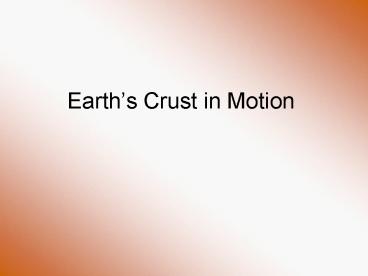Earths Crust in Motion - PowerPoint PPT Presentation
1 / 10
Title:
Earths Crust in Motion
Description:
Left of the fissure, the North American Plate is pulling westward away from the ... Syncline - A fold that bends downward in the middle to form a bowl ... – PowerPoint PPT presentation
Number of Views:589
Avg rating:3.0/5.0
Title: Earths Crust in Motion
1
Earths Crust in Motion
2
(No Transcript)
3
Lava fountains (10 m high) spouting from eruptive
fissures during the October 1980 eruption of
Krafla Volcano. (Photograph by Gudmundur E.
Sigvaldason, Nordic Volcanological Institute,
Reykjavik, Iceland.)
4
Aerial view of the area around Thingvellir,
Iceland, showing a fissure zone (in shadow) that
is an on-land exposure of the Mid-Atlantic Ridge.
Left of the fissure, the North American Plate is
pulling westward away from the Eurasian Plate
(right of fissure). This photograph encompasses
the historical tourist area of Thingvellir, the
site of Iceland's first parliament, called the
Althing, founded around the year A.D. 930. Large
building (upper center) is a hotel for visitors.
(Photograph by Oddur Sigurdsson, National Energy
Authority, Iceland.)
5
- Earthquake
- the shaking and trembling that results from the
movement of rock beneath Earths surface. - Stress
- A force that acts on rock to change its shape or
volume - Stress adds energy to the rock. The energy is
stored in the rock until it changes shape or
breaks. - Deformation
- the change in the shape or volume of the crust
- Three kinds of stress cause deformation
- shearing
- tension
- compression
6
- Shearing pushes a mass of rock in two opposite
directions. - Tension pulls on the crust, stretching rock.
- Compression squeezes rock until it folds or
breaks. - Shearing, tension, and compression work over
millions of years to change the shape and volume
of rock. - When stress builds up in rock, it fractures along
a fault. A fault is a break in Earths crust
where slabs of crust slip past each other. Faults
usually occur along plate boundaries, where the
forces of plate motion compress, pull, or shear
the crust so much that the crust breaks. - Three main types of faults.
- strike-slip fault, the rocks on either side of
the fault slide past each other sideways with
little up-or down motion. Strike-slip faults are
caused by shearing. - normal fault, one block of rock lies above the
fault while the other block lies below it. The
block that lies above the fault is the hanging
wall, and the block below the fault is the
footwall. Normal faults are caused by tension.
7
- reverse fault,
- the hanging wall slides upward past the footwall.
- Reverse faults are caused by compression.
Normal fault
Reverse Fault
8
Aerial view of the San Andreas fault slicing
through the Carrizo Plain in the Temblor Range
east of the city of San Luis Obispo. (Photograph
by Robert E. Wallace, USGS.)
9
- Earthquake
- Stress builds up due to friction
- Release of that energy
10
- fault block mountain
- Two normal faults uplift a block of rock
- Fold
- A bend in rock that forms when compression
shortens and thickens part of the crust - Two types
- Anticline - A fold that bends upward in an arch
- Syncline - A fold that bends downward in the
middle to form a bowl - Plateau - a large area of flat land elevated high
above sea level - When a fault pushes up a large, flat block of
rock, a plateau can form































